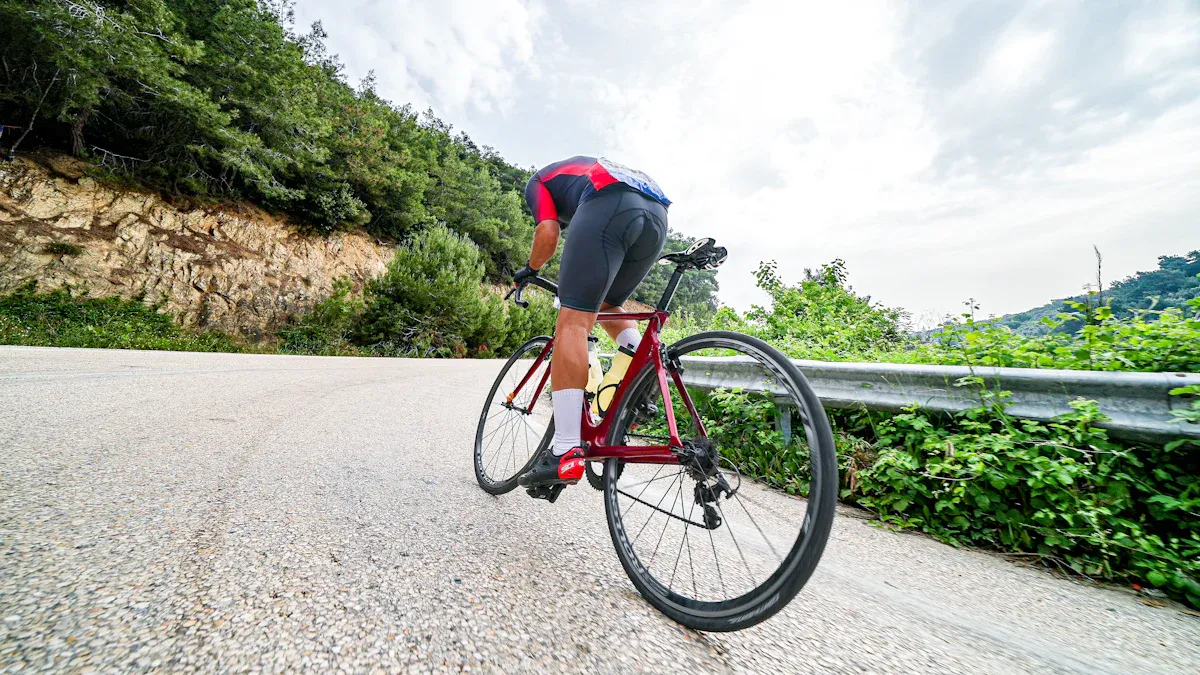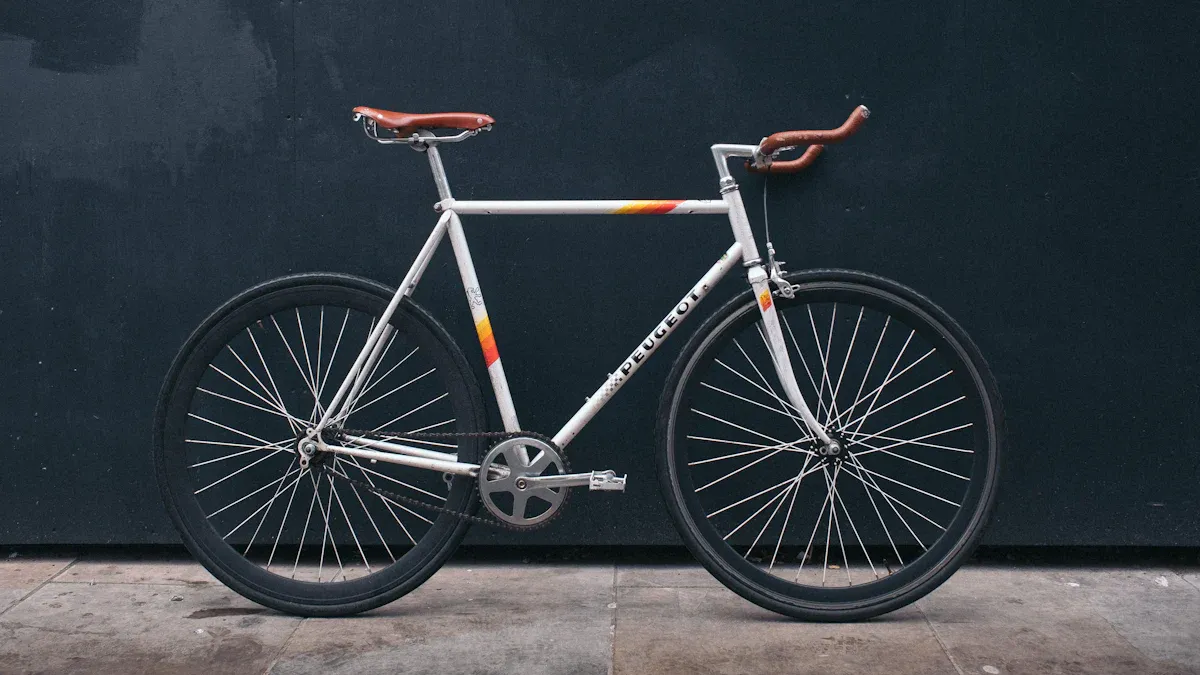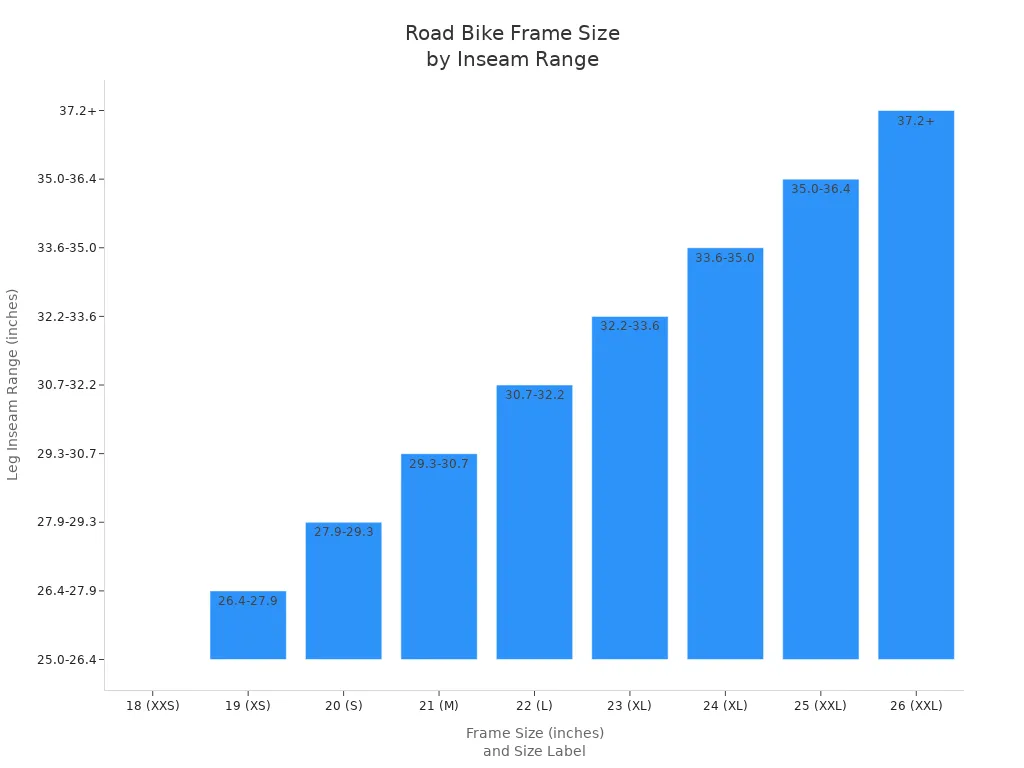
Finding the right size bike starts with measuring your height and inseam. When you ride a bike that fits, you feel more comfortable, stay safer, and perform better. Nearly 80% of cyclists use bikes that are the wrong size, which leads to poor posture and even pain. Studies show that the right size bike frame helps reduce muscle fatigue and boosts your riding power. If you want a perfect fit, check a mens bike frame size chart and look for these things:
Make sure you have at least an inch of clearance over the top tube.
Adjust your seat so your knee bends about 15-20° at the lowest pedal point.
Notice how far you reach to the handlebars.
Think about your riding style and body proportions.
You can do this yourself, and it’s easier than you think!
Key Takeaways
Measure your height and inseam with care. Use a size chart or formula to pick the right bike frame size.
Check standover clearance and reach for comfort and safety. This helps you have good riding posture.
Try riding different bike sizes to see which one fits you best. Pick the one that feels right for your body and riding style.
Change bike parts like saddle height and handlebar position. This can make you more comfortable and help you ride better.
Think about getting a professional bike fitting. An expert can help stop pain and help you ride stronger.
Why the Right Size Bike Matters

Comfort and Safety
When you ride a bike that fits, you feel the difference right away. The right size bike helps you sit in a natural position. Your back stays straight, and your arms reach the handlebars without stretching too far. You avoid pain in your knees, shoulders, and neck. If you pick the wrong bike frame size, you might feel cramped or stretched out. That can lead to soreness or even injuries over time.
You want to feel safe every time you hop on your bike. A good fit lets you touch the ground with your feet when you stop. You can control your bike better, especially when you need to brake quickly or turn fast. Here’s a quick tip:
If you stand over the top tube and have at least an inch of space, you’re on the right track for comfort and safety.
Performance Benefits
Choosing the right size bike does more than keep you comfortable. It helps you ride faster and longer. When your bike frame size matches your body, you pedal with more power. Your muscles work together, so you don’t waste energy. You climb hills easier and keep up speed on flat roads.
A bike that fits well also makes your rides more fun. You feel confident, and you want to ride more often. You don’t have to worry about aches or awkward movements. Here’s a simple table to show how the right fit affects your ride:
Benefit | Wrong Size Bike | Right Size Bike |
|---|---|---|
Comfort | Low | High |
Safety | Risky | Secure |
Power | Weak | Strong |
Fun | Less | More |
If you want to enjoy every ride, pay attention to your bike frame size. You’ll notice the difference from your very first trip.
Guide to Bicycle Frame Selection

Choosing a bike that fits you starts with a few simple steps. This guide will walk you through measuring your height and inseam, using a mens bike frame size chart, and checking standover and reach. You’ll learn how to select the right size and feel confident every time you ride.
Measure Height and Inseam
You need two measurements before you look at any bike frame size chart: your height and your inseam. Your inseam is the distance from your crotch to the floor. This number helps you find the proper size for your bike frame.
Here’s how you measure your inseam:
Stand barefoot on a hard floor with your back against a wall.
Take a book and press it firmly up between your legs, right to your sit bones.
Make sure the book is flat against the wall.
Ask someone to measure from the top of the book to the floor.
Repeat this a few times and use the largest number.
You can also use a yardstick or a dowel with a level if you want to be extra precise.
Tip: Always measure your inseam before you buy a bike. Height alone doesn’t tell the whole story because everyone’s legs are different.
Here’s a table to help you understand the steps:
Step | Description |
|---|---|
1 | Pick your bike type first (road, mountain, city) since frame shapes differ. |
2 | Measure your leg inseam: crotch to floor, barefoot. |
3 | Measure your height as a backup if you can’t get your inseam. |
4 | Use a size guide or bike size chart for your bike type. |
5 | Try this formula: Frame size ≈ Leg inseam × 0.7 (road/mountain) or × 0.68 (city). |
6 | Adjust the bike after you pick your frame for best comfort. |
Use Mens Bike Frame Size Chart
Once you have your measurements, you can use a mens bike frame size chart. These charts match your inseam and height to the right size of frame. They make bicycle frame selection much easier and help you avoid common mistakes, like picking a bike based only on wheel size.
Cycling professionals say that a mens bike frame size chart helps you:
Find the correct frame for comfort and efficiency.
Avoid injuries from poor fit.
Improve your power and control.
Make buying online easier.
Understand different sizing systems from brands.
Get close to the ideal fit before you see a professional.
Here’s an example of a bike sizing guide for road bikes:
Leg Inseam (in) | Height (ft/in) | Frame Size (inches) | Size Label |
|---|---|---|---|
25.0 – 26.4 | 4’7″ – 4’11” | 18 | XXS |
26.4 – 27.9 | 4’8″ – 5’1″ | 19 | XS |
27.9 – 29.3 | 5’0″ – 5’5″ | 20 | S |
29.3 – 30.7 | 5’3″ – 5’8″ | 21 | M |
30.7 – 32.2 | 5’6″ – 6’0″ | 22 | L |
32.2 – 33.6 | 5’10” – 6’2″ | 23 | XL |
33.6 – 35.0 | 6’0″ – 6’5″ | 24 | XL |
35.0 – 36.4 | 6’3″ – 6’8″ | 25 | XXL |
37.2+ | 6’6″+ | 26 | XXL |

Keep in mind, a mens bike frame size chart can look different depending on the brand and bike type. Road bikes use centimeters for frame size, mountain bikes use inches or labels like S/M/L, and kids bikes use wheel diameter. Always check the size guide for your bike type.
Bike Type | Measurement Units | Size Categories | Notes on Variation |
|---|---|---|---|
Road Bikes | Centimeters (seat tube length) | Numeric sizes (e.g., 47, 50, 52, etc.) | Sizes based on seat tube length; sizing can vary slightly by brand. |
Mountain Bikes | Inches or Small/Medium/Large | Letter sizes (XS, S, M, L, XL, XXL) | Newer geometries make sizing less straightforward; some use frame length in inches, others use size categories. |
Hybrid Bikes | Similar to mountain bikes or road bikes | Mixed numeric or letter sizes | Varies by manufacturer. |
Kids Bikes | Wheel diameter (inches) | Wheel sizes (e.g., 20″, 24″) | Different measurement system from adult bikes. |
Note: There’s no universal standard for bike frame size. Always use the chart for your brand and bike style.
If you want a quick estimate, use this formula: Frame size ≈ Leg inseam × 0.7 for road and mountain bikes. For city bikes, use × 0.68. This helps you select the right size even if you don’t have a chart handy.
Check Standover and Reach
After you pick your frame size, you need to check standover clearance and reach. These two things make sure your bike feels safe and comfortable.
Standover Clearance:
Stand over the bike’s top tube. You should have about 1 to 2 inches of space between your crotch and the tube. This gap lets you get on and off easily and keeps you safe if you need to stop quickly. Mountain bikes sometimes need a bit more clearance for rough trails.
Reach:
Reach is how far you stretch to grab the handlebars. It affects your posture, comfort, and power. If the reach is right, your elbows bend slightly, and your back stays natural. You don’t want to feel cramped or stretched out. The ideal position is a 45-degree angle from your hips to your torso and a 90-degree angle from your torso to your arms.
Reach sets your horizontal position and helps you keep a neutral spine.
Good reach means you can pedal strong and avoid pain in your neck, back, or knees.
If you feel too stretched or cramped, you may need a different frame or to adjust the stem and handlebars.
Tip: Signs of bad reach include pain, trouble keeping power, or feeling awkward on the bike. Adjust your setup until you feel comfortable.
Here’s a quick checklist for a properly selected bicycle frame:
You have 1-2 inches of standover clearance.
Your elbows bend slightly when you grip the handlebars.
Your back feels relaxed, not hunched or overextended.
You can pedal smoothly and keep a steady cadence.
A correctly selected bicycle frame gives you confidence and control. Use this guide and a mens bike frame size chart to make sure you get the right size bike. If you follow these steps, you’ll enjoy every ride and avoid common mistakes.
Choosing Between Sizes
Consider Arm Span and Torso Length
Sometimes you find yourself between two frame sizes. You might wonder which one feels better for you. Your arm span and torso length can help you decide. If your wingspan is longer than your height, you may want to size up, especially for road bikes. This gives you more room to stretch out and helps you avoid feeling cramped.
Arm span greater than height often means you should pick the larger frame.
Leg inseam and height are still the main things to measure first.
Torso length does not change the frame size much, but it can affect how you feel on the bike.
Tip: If you have long arms, a bigger frame can make your ride smoother and more comfortable.
Choosing the right size bike frame is not just about numbers. You need to think about your body shape and how you like to ride. If you feel unsure, try both sizes and see which one fits your style.
Test Ride for Fit
You can read charts and measure yourself, but nothing beats a test ride. Big bike brands like Canyon, Norco, and Santa Cruz say that test rides help you find the right bike size. When you try different frames, you feel how each one handles, turns, and fits your body.
Test rides let you feel the difference between stability and maneuverability.
You notice how the bike responds to your movements.
You can check if your reach feels natural and if your feet touch the ground easily.
A test ride shows you what a good bike fit feels like. You get to see how your body moves with the bike. If you visit a local shop, you can try different sizes and ask for advice. This hands-on approach helps you make the best choice for your comfort and riding style.
Note: Sizing charts give you a starting point, but your personal experience matters most. Trust how you feel on the bike.
If you are between sizes, a test ride helps you pick the frame that matches your needs. You want every ride to feel smooth and fun. The right bike size makes all the difference.
Final Tips for the Right Fit
Adjust Components
You might think picking the best size bike is the last step, but small tweaks can make a huge difference. Even after you find the right bike size, you should adjust the parts to match your body. Here’s a simple checklist to help you get the most out of your bike fit:
Saddle angle: Start with the saddle level. Some men like a slight upward tilt for extra support.
Saddle height: Try the heel method. Sit on the saddle, put your heels on the pedals, and straighten your legs. Your hips should stay level, and your knees should bend just a little when you pedal.
Saddle fore/aft position: Drop a string from your kneecap. It should line up with the pedal axle. This helps you pedal with power and keeps your knees happy.
Handlebar height and reach: Set the handlebars so your arms bend slightly. You want to avoid stretching too far or feeling cramped.
Tip: Make small changes one at a time. Ride your bike after each adjustment to see how it feels. If you feel pain or numbness, try a different setting.
Getting these details right can help you ride longer and feel more comfortable. If you ever feel stuck, a bike fitting expert can help you fine-tune everything.
Professional Fitting
Sometimes, you need a little extra help to get the perfect bike fit. A professional bike fitting gives you a custom setup that matches your body and riding style. Fitters look at your comfort, flexibility, and how you ride. They use special tools to measure your body and adjust your bike for the best results.
A pro bike fitting can:
Prevent neck, back, and knee pain.
Help you ride farther and climb hills with more power.
Improve your control, safety, and confidence.
Make your rides smoother and more fun.
Most bike fitting sessions last about 2 to 3 hours. The cost can range from SGD 690 to SGD 1100, depending on the service. Here’s a quick look:
Bike Fitting Service | Duration | Cost (SGD) |
|---|---|---|
Performance Bike Fit (Standard) | 2-3 hours | 690-790 |
Retül Premium Bike Fit | 3 hours | 1100 |
Note: Many fitters let you come back for free adjustments if you feel discomfort later. This helps you keep your bike fit dialed in as you ride more.
If you want the right bike size and the best comfort, a professional bike fitting is a smart move. You get advice from experts who know how to make every ride better.
Choosing the right bike frame size feels easy when you follow expert steps:
Step | What You Do |
|---|---|
1. | Measure your inseam and height |
2. | Use a size chart for your bike type |
3. | Try a simple sizing formula |
4. | Think about your riding style |
5. | Test ride different sizes |
6. | Check the brand’s recommendations |
7. | Remember, fit is personal |
Size charts give you a strong starting point. Test rides let you feel the difference in comfort and control. If you still feel unsure, expert bike shops and fitting services can help you ride with confidence and enjoy every mile. 🚴♂️
FAQ
How do I know if I picked the right size bike frame?
You should feel comfortable when you ride. Your feet touch the ground, and your knees bend just right. If you used a bike size chart or a mens bike frame size chart, you likely found the proper size.
What if I am between two bike frame sizes?
Try both sizes if you can. A test ride helps you decide. Sometimes, choosing the right size bike frame means picking the smaller one for control or the bigger one for more reach. Use a size guide for extra help.
Can I adjust my bike if it does not feel right?
Yes! You can move the saddle or change the handlebar height. Small changes make a big difference. A bike fitting at a shop can help you select the right size and get a properly selected bicycle frame.
Do all brands use the same bike size chart?
No, each brand may use a different bike sizing guide. Always check the size guide for your bike type. This step helps you with bicycle frame selection and ensures you get the right size of frame.
See Also
Choosing The Best Bike Frame For Comfort And Speed
Understanding Racing Bike Frame Sizes For All Cyclists
Simplifying Large Mountain Bike Frame Sizes And Geometry
